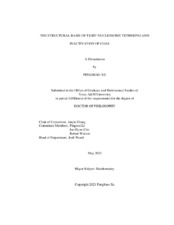| dc.description.abstract | Cells defend against bacteria and viruses’ invasion through their immune system. Innate immunity employs a wide spectrum of germ-line encoded pattern-recognition receptors (PRRs) to sense microbial infection and initiate a protective immune response. The detection of foreign nucleic acids is a central strategy in the innate immune system. The innate immune system has evolved to distinguish pathogenic RNA by secondary structure or specific modifications. However, DNA recognition has more complicated systems. Because the cellular DNA normally presents in the nuclei and mitochondria, the accumulation of cytosolic DNA is always a danger signal, either from pathogens or from the host self itself.
Cyclic GMP-AMP synthase (cGAS) is a cytosolic DNA sensor that catalyzes the synthesis of a cyclic dinucleotide second messenger, c[G(2',5')pA(3',5')p] cGAMP. 2’3’-cGAMP binds to the adaptor STING (Stimulator of interferon genes protein), which forms puncta on the ER membrane and mediates the recruitment and activation of the protein kinase TBK1 and transcription factor IRF-3. Phosphorylated IRF-3 translocates to the nucleus and induces the expression of type I interferons.
Recently studies also identified that endogenous cGAS is predominantly a nuclear protein. cGAS locating inside the nuclei tethers tightly with chromatin and maintains the inactive state. In this work, a mechanism of cGAS being inhibited by nucleosomes was studied. A hybrid structure model of mouse cGAS in complex with human nucleosome was established. cGAS binds to the acidic patch on the nucleosome and several key residues were identified for both cGAS and nucleosome for the interaction. The study determined that even in the existence of nucleosome DNA, the cGAS in the complex is in its inactive state and the complex clashes in space for binding extra dsDNA.
Another part of this thesis was dedicated to understanding the molecular mechanisms governing how cGAMP activates STING at the ER membrane. The N-terminal transmembrane domain of STING is essential for STING oligomerization and signaling. Moreover, cGAMP binding induces the oligomerization of full-length STING both in vitro and in vivo. The central hypothesis is that cGAMP binding makes the conformational changes of STING dimer located discretely on the ER membrane, and increases the affinity of STING dimers to form oligomer, which facilitates the activation of kinase TBK1. These comprehensive structural and functional studies provide new insights into the mechanism of STING activation.
Taken together, this work presents an advanced understanding of the cGAS-STING pathway. These findings provide a structural basis for the development of cGAS and STING agonists and antagonists for the treatment of cancer and autoimmune disorders. | en |


